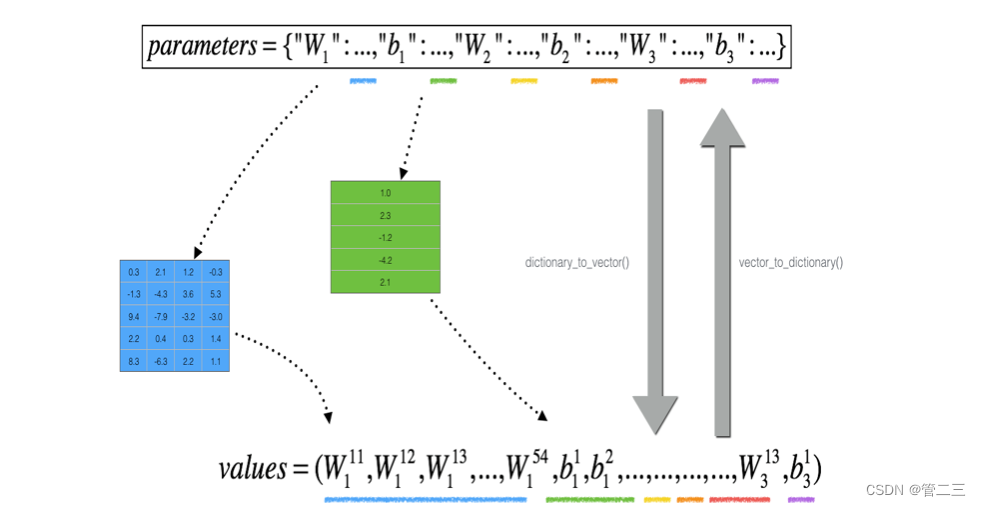梯度校验
你是一个致力于让全球移动支付可用的团队的一员,并被要求构建一个深度学习模型来检测欺诈——无论何时有人进行支付,你都希望看到支付是否可能是欺诈的,比如用户的账户是否已被黑客接管。
但是实现反向传播是相当具有挑战性的,有时还会有bug。因为这是一个任务关键型应用程序,所以公司的CEO希望真正确定反向传播的实现是否正确。你的CEO说:“给我一个证明,证明你的反向传播确实有效!”为了保证这一点,你将使用“梯度校验”。
导数的定义:
 利用这个定义以及一个极小的ε来证明反向传播的代码是正确的。
利用这个定义以及一个极小的ε来证明反向传播的代码是正确的。
一维梯度校验
实现一个一维度的前向传播和后向传播,通过梯度校验来进行验证。
前向传播:
def forward_propagation(x, theta):
J = theta * x
return J
测试:
x, theta = 2, 4
J = forward_propagation(x, theta)
print ("J = " + str(J))
结果:
J = 8
后向传播:
def backward_propagation(x, theta):
dtheta = x
return dtheta
测试:
x, theta = 2, 4
dtheta = backward_propagation(x, theta)
print ("dtheta = " + str(dtheta))
结果:
dtheta = 2
梯度校验:
步骤:
- 𝜃+=𝜃+𝜀
- 𝜃-=𝜃-𝜀
- J+=J(𝜃+)
- J-=J(𝜃-)
- 𝑔𝑟𝑎𝑑𝑎𝑝𝑝𝑟𝑜𝑥=(𝐽+−𝐽−)/2𝜀
接下来,计算梯度的反向传播值,最后计算误差:
 当difference小于10-7时,结果一般正确。
当difference小于10-7时,结果一般正确。
np.linalg.norm()用于求范数,linalg本意为linear(线性) + algebra(代数),norm则表示范数。
np.linalg.norm(x, ord=None, axis=None, keepdims=False)
def gradient_check(x, theta, epsilon = 1e-7):
thetamax = theta + epsilon
thetamin = theta - epsilon
Jmax = thetamax * x
Jmin = thetamin * x
gradapprox = (Jmax-Jmin)/(2*epsilon)
grad = backward_propagation(x, theta)
difference = np.linalg.norm(grad - gradapprox) / (np.linalg.norm(grad)+np.linalg.norm(gradapprox))
if difference < 1e-7:
print ("The gradient is correct!")
else:
print ("The gradient is wrong!")
return difference
测试:
x, theta = 2, 4
difference = gradient_check(x, theta)
print("difference = " + str(difference))
结果:
The gradient is correct!
difference = 2.919335883291695e-10
高维梯度检验
高维参数计算如下图:
 老样子先实现前向传播和后向传播。
老样子先实现前向传播和后向传播。
def forward_propagation_n(X, Y, parameters):
m = X.shape[1]
W1 = parameters["W1"]
b1 = parameters["b1"]
W2 = parameters["W2"]
b2 = parameters["b2"]
W3 = parameters["W3"]
b3 = parameters["b3"]
Z1 = np.dot(W1, X) + b1
A1 = relu(Z1)
Z2 = np.dot(W2, A1) + b2
A2 = relu(Z2)
Z3 = np.dot(W3, A2) + b3
A3 = sigmoid(Z3)
logprobs = np.multiply(-np.log(A3),Y) + np.multiply(-np.log(1 - A3), 1 - Y)
cost = 1./m * np.sum(logprobs)
cache = (Z1, A1, W1, b1, Z2, A2, W2, b2, Z3, A3, W3, b3)
return cost, cache
def backward_propagation_n(X, Y, cache):
m = X.shape[1]
(Z1, A1, W1, b1, Z2, A2, W2, b2, Z3, A3, W3, b3) = cache
dZ3 = A3 - Y
dW3 = 1./m * np.dot(dZ3, A2.T)
db3 = 1./m * np.sum(dZ3, axis=1, keepdims = True)
dA2 = np.dot(W3.T, dZ3)
dZ2 = np.multiply(dA2, np.int64(A2 > 0))
dW2 = 1./m * np.dot(dZ2, A1.T) * 2
db2 = 1./m * np.sum(dZ2, axis=1, keepdims = True)
dA1 = np.dot(W2.T, dZ2)
dZ1 = np.multiply(dA1, np.int64(A1 > 0))
dW1 = 1./m * np.dot(dZ1, X.T)
db1 = 4./m * np.sum(dZ1, axis=1, keepdims = True)
gradients = {"dZ3": dZ3, "dW3": dW3, "db3": db3,
"dA2": dA2, "dZ2": dZ2, "dW2": dW2, "db2": db2,
"dA1": dA1, "dZ1": dZ1, "dW1": dW1, "db1": db1}
return gradients
想比较“gradapprox”与反向传播计算的梯度。 该公式仍然是𝑔𝑟𝑎𝑑𝑎𝑝𝑝𝑟𝑜𝑥=(𝐽+−𝐽−)/2𝜀。
但是θ不再是标量。 这是一个名为“parameters”的字典。 我们为你实现了一个函数“dictionary_to_vector()”。 它将“parameters”字典转换为一个称为“values”的向量,通过将所有参数(W1,b1,W2,b2,W3,b3)整形为向量并将它们连接起来而获得。 反函数是“vector_to_dictionary”,它返回“parameters”字典。还使用gradients_to_vector()将“gradients”字典转换为向量“grad”。不用担心这个。
 步骤:
步骤:
- 将𝜃+设置为np.copy(parameters_values)
- 𝜃+i=𝜃+i+𝜀
- J+i=forward_propagation_n(x, y, vector_to_dictionary(θ+))
- 计算𝜃-,步骤同上
- 𝑔𝑟𝑎𝑑𝑎𝑝𝑝𝑟𝑜𝑥[i]=(𝐽+−𝐽−)/2𝜀

def gradient_check_n(parameters, gradients, X, Y, epsilon = 1e-7):
parameters_values, keys = dictionary_to_vector(parameters)
grad = gradients_to_vector(gradients)
num_parameters = parameters_values.shape[0]
J_plus = np.zeros((num_parameters, 1))
J_minus = np.zeros((num_parameters, 1))
gradapprox = np.zeros((num_parameters, 1))
for i in range(num_parameters):
thetamax = np.copy(parameters_values)
thetamax = thetamax + epsilon
J_plus[i],cache = forward_propagation_n(X, Y,vector_to_dictionary(thetamax))
thetamin = np.copy(parameters_values)
thetamin = thetamin - epsilon
J_minus[i],cache = forward_propagation_n(X, Y,vector_to_dictionary(thetamin))
gradapprox[i] = (J_plus[i] - J_minus[i])/(2*epsilon)
numerator = np.linalg.norm(grad - gradapprox)
denominator = np.linalg.norm(grad)+np.linalg.norm(gradapprox)
difference = numerator/denominator
if difference > 1e-7:
print ("\033[93m" + "There is a mistake in the backward propagation! difference = " + str(difference) + "\033[0m")
else:
print ("\033[92m" + "Your backward propagation works perfectly fine! difference = " + str(difference) + "\033[0m")
return difference
测试:
X, Y, parameters = gradient_check_n_test_case()
cost, cache = forward_propagation_n(X, Y, parameters)
gradients = backward_propagation_n(X, Y, cache)
difference = gradient_check_n(parameters, gradients, X, Y)
结果:
There is a mistake in the backward propagation! difference = 0.6977810638279843





















 724
724











 被折叠的 条评论
为什么被折叠?
被折叠的 条评论
为什么被折叠?








